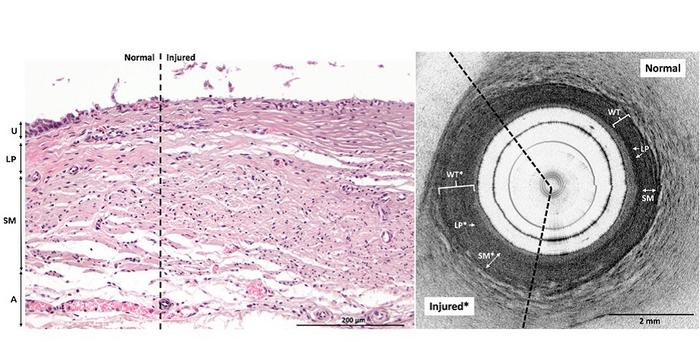In a groundbreaking study, scientists have explored a novel approach to detect electrothermal ureteral injuries, a common complication during pelvic surgery. The ureters, delicate tubes that transport urine from the kidneys to the bladder, are particularly vulnerable due to their proximity to other anatomical structures. Unfortunately, current detection methods often fall short in promptly identifying subtle thermal injuries, which can take days or even weeks to manifest.

Credit: Long et al., doi 10.1117/1.BIOS.1.1.015001.
In a groundbreaking study, scientists have explored a novel approach to detect electrothermal ureteral injuries, a common complication during pelvic surgery. The ureters, delicate tubes that transport urine from the kidneys to the bladder, are particularly vulnerable due to their proximity to other anatomical structures. Unfortunately, current detection methods often fall short in promptly identifying subtle thermal injuries, which can take days or even weeks to manifest.
Enter optical coherence tomography (OCT) endoscopy—a minimally invasive imaging technique that may revolutionize ureteral injury detection. In research reported in Biophotonics Discovery (BIOS), an interdisciplinary team led by researchers from the University of Arizona’s Department of Biomedical Engineering externally applied electrothermal energy to explanted pig ureters, simulating a spectrum of injury severity. Immediately afterward, they performed OCT endoscopy and compared the resulting images to histology as the gold standard for interpretation.
The findings were remarkable. Lesion size on OCT images correlated with the treatment power used, providing a quantitative measure of injury severity. Moreover, qualitative markers of injury were detectable in nearly all cases, except for one lesion treated at low power. Physicians, trained to identify these features based on established criteria, achieved an impressive average sensitivity of 82 percent and specificity of 96 percent in lesion detection.
Despite the study’s small sample size and its ex vivo nature (meaning the experiments were conducted outside a living organism), the results suggest that OCT endoscopy holds great promise. By enabling timely and accurate identification of electrothermal ureteral injury, this innovative technique could significantly improve patient outcomes and reduce postoperative complications. Surgeons may soon have a powerful tool at their disposal—one that enhances safety and precision during pelvic surgeries.
BIOS Editor-in-Chief Darren Roblyer of Boston University remarks, “This study provides an important step towards protecting patients from ureteral injuries during pelvic surgery. OCT is label-free, safe for the patient, and can be integrated into a remarkably small-diameter endoscope, provide a potentially excellent means for detecting and ultimately preventing these unfortunate injuries.”
The study’s authors recommend further clinical validation to confirm their promising results.
For details, see the original Gold Open Access article by D. J. Long et al., “Optical coherence tomography for the detection of electrothermal ureteral injury in an ex-vivo porcine model,” Biophoton. Discovery 1(1) 015001 (2024), doi 10.1117/1.BIOS.1.1.015001.
The article is published in the inaugural issue of Biophotonics Discovery.
Article Title
Optical coherence tomography for the detection of electrothermal ureteral injury in an ex-vivo porcine model
Article Publication Date
20-May-2024
Discover more from Science
Subscribe to get the latest posts sent to your email.


